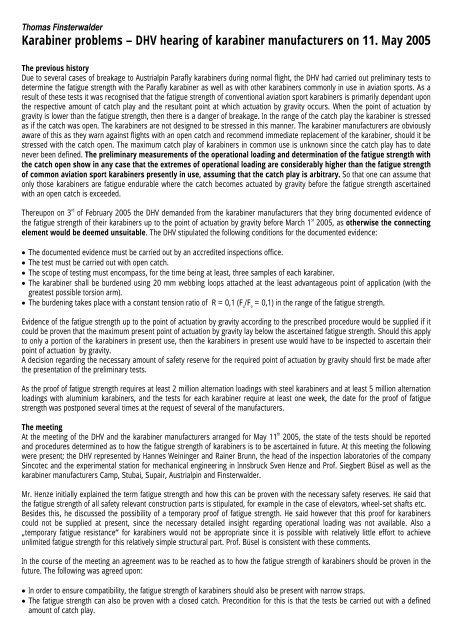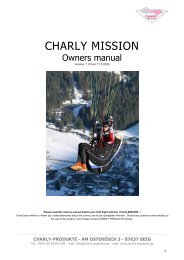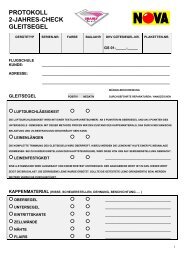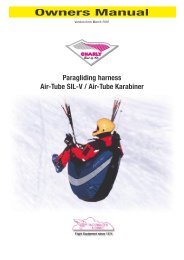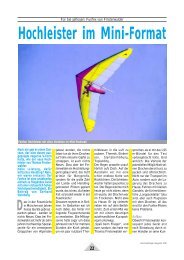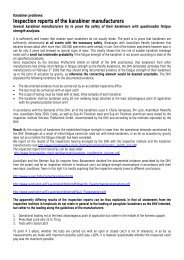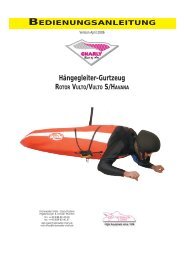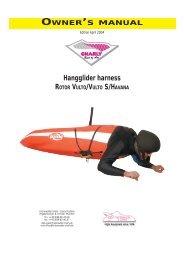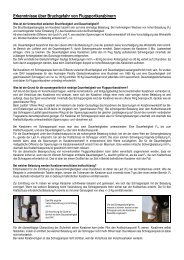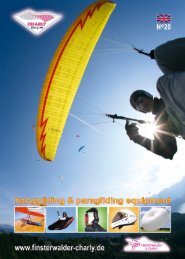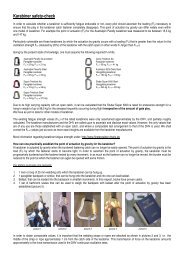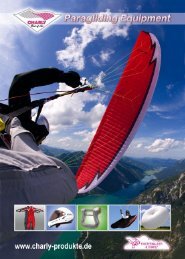Karabiner problems - Finsterwalder Gmbh
Karabiner problems - Finsterwalder Gmbh
Karabiner problems - Finsterwalder Gmbh
You also want an ePaper? Increase the reach of your titles
YUMPU automatically turns print PDFs into web optimized ePapers that Google loves.
Thomas <strong>Finsterwalder</strong><br />
<strong>Karabiner</strong> <strong>problems</strong> – DHV hearing of karabiner manufacturers on 11. May 2005<br />
The previous history<br />
Due to several cases of breakage to Austrialpin Parafly karabiners during normal flight, the DHV had carried out preliminary tests to<br />
determine the fatigue strength with the Parafly karabiner as well as with other karabiners commonly in use in aviation sports. As a<br />
result of these tests it was recognised that the fatigue strength of conventional aviation sport karabiners is primarily dependant upon<br />
the respective amount of catch play and the resultant point at which actuation by gravity occurs. When the point of actuation by<br />
gravity is lower than the fatigue strength, then there is a danger of breakage. In the range of the catch play the karabiner is stressed<br />
as if the catch was open. The karabiners are not designed to be stressed in this manner. The karabiner manufacturers are obviously<br />
aware of this as they warn against flights with an open catch and recommend immediate replacement of the karabiner, should it be<br />
stressed with the catch open. The maximum catch play of karabiners in common use is unknown since the catch play has to date<br />
never been defined. The preliminary measurements of the operational loading and determination of the fatigue strength with<br />
the catch open show in any case that the extremes of operational loading are considerably higher than the fatigue strength<br />
of common aviation sport karabiners presently in use, assuming that the catch play is arbitrary. So that one can assume that<br />
only those karabiners are fatigue endurable where the catch becomes actuated by gravity before the fatigue strength ascertained<br />
with an open catch is exceeded.<br />
Thereupon on 3 rd of February 2005 the DHV demanded from the karabiner manufacturers that they bring documented evidence of<br />
the fatigue strength of their karabiners up to the point of actuation by gravity before March 1 st 2005, as otherwise the connecting<br />
element would be deemed unsuitable. The DHV stipulated the following conditions for the documented evidence:<br />
• The documented evidence must be carried out by an accredited inspections office.<br />
• The test must be carried out with open catch.<br />
• The scope of testing must encompass, for the time being at least, three samples of each karabiner.<br />
• The karabiner shall be burdened using 20 mm webbing loops attached at the least advantageous point of application (with the<br />
greatest possible torsion arm).<br />
• The burdening takes place with a constant tension ratio of R = 0,1 (F u /F o = 0,1) in the range of the fatigue strength.<br />
Evidence of the fatigue strength up to the point of actuation by gravity according to the prescribed procedure would be supplied if it<br />
could be proven that the maximum present point of actuation by gravity lay below the ascertained fatigue strength. Should this apply<br />
to only a portion of the karabiners in present use, then the karabiners in present use would have to be inspected to ascertain their<br />
point of actuation by gravity.<br />
A decision regarding the necessary amount of safety reserve for the required point of actuation by gravity should first be made after<br />
the presentation of the preliminary tests.<br />
As the proof of fatigue strength requires at least 2 million alternation loadings with steel karabiners and at least 5 million alternation<br />
loadings with aluminium karabiners, and the tests for each karabiner require at least one week, the date for the proof of fatigue<br />
strength was postponed several times at the request of several of the manufacturers.<br />
The meeting<br />
At the meeting of the DHV and the karabiner manufacturers arranged for May 11 th<br />
2005, the state of the tests should be reported<br />
and procedures determined as to how the fatigue strength of karabiners is to be ascertained in future. At this meeting the following<br />
were present; the DHV represented by Hannes Weininger and Rainer Brunn, the head of the inspection laboratories of the company<br />
Sincotec and the experimental station for mechanical engineering in Innsbruck Sven Henze and Prof. Siegbert Büsel as well as the<br />
karabiner manufacturers Camp, Stubai, Supair, Austrialpin and <strong>Finsterwalder</strong>.<br />
Mr. Henze initially explained the term fatigue strength and how this can be proven with the necessary safety reserves. He said that<br />
the fatigue strength of all safety relevant construction parts is stipulated, for example in the case of elevators, wheel-set shafts etc.<br />
Besides this, he discussed the possibility of a temporary proof of fatigue strength. He said however that this proof for karabiners<br />
could not be supplied at present, since the necessary detailed insight regarding operational loading was not available. Also a<br />
„temporary fatigue resistance“ for karabiners would not be appropriate since it is possible with relatively little effort to achieve<br />
unlimited fatigue strength for this relatively simple structural part. Prof. Büsel is consistent with these comments.<br />
In the course of the meeting an agreement was to be reached as to how the fatigue strength of karabiners should be proven in the<br />
future. The following was agreed upon:<br />
• In order to ensure compatibility, the fatigue strength of karabiners should also be present with narrow straps.<br />
• The fatigue strength can also be proven with a closed catch. Precondition for this is that the tests be carried out with a defined<br />
amount of catch play.
• As regards the point of application one is in agreement that the test arrangement can also be carried out in the middle of the strap<br />
support and not at the least advantageous point of application, on condition that suitable safety margins (still to be determined)<br />
account for the case of the least advantageous point of application.<br />
• The evidence of fatigue strength should be carried out not only to the point of actuation by gravity of the karabiner, but for the<br />
whole range of operational loading.<br />
• Further still, Hannes Weininger in cooperation with Sven Henze should decide within the following two months on the size of the<br />
safety margin necessary for the test arrangement and how high the operational loading is to be verified.<br />
Presentation of the fatigue strength test results of the karabiner manufacturers:<br />
Indeed all of the manufacturers present with the exception of the company Stubai had carried out tests, however, no manufacturer<br />
(with the exception of the company <strong>Finsterwalder</strong>) was able to provide evidence of the fatigue strength as demanded by the DHV on<br />
February 3 rd .<br />
None of the manufacturers, with the exception of the company <strong>Finsterwalder</strong>, carried out the tests according to the stipulations of<br />
the DHV, in that the fatigue strength had to be ascertained with the catch of the karabiner open. Accordingly, the maximum<br />
permissible catch play/maximum permissible point of actuation by gravity of karabiners in use was ascertained by none of the<br />
manufacturers.<br />
In this respect there exist only the preliminary tests from the company <strong>Finsterwalder</strong> and the preliminary tests of commonly used<br />
karabiners by the inspections laboratory, commissioned by the DHV, which resulted in the following (see also the test report of the<br />
company Sincotec GmbH):<br />
Type<br />
Column No. 1 2 3 4 5 6 7<br />
Supair Twistlock<br />
Steel paragliding karabiner<br />
Supair Twistlock<br />
Alu paragliding karabiner<br />
Austrialpin Parafly<br />
Alu paragliding karabiner<br />
Austrialpin Powerfly<br />
Steel paragliding karabiner<br />
Camp Twistlock<br />
Alu paragliding karabiner<br />
Austrialpin 3200 Delta<br />
Steel hanggliding karabiner<br />
<strong>Finsterwalder</strong> SIL<br />
Paragliding karabiner<br />
<strong>Finsterwalder</strong> Quick Out<br />
Alu paragliding karabiner<br />
<strong>Finsterwalder</strong> Pin Lock<br />
Alu paragliding karabiner<br />
Number of karabiners tested<br />
for fatigue endurance<br />
Breakage<br />
at<br />
F o<br />
Highest ascertained<br />
sweep at F o<br />
Estimated mean value of<br />
fatigue endurance acc.<br />
to testing institute<br />
Highest ascertained<br />
point od actuation by<br />
gravity<br />
Lowest ascertained<br />
point od actuation by<br />
gravity<br />
Number of karabiners<br />
tested for point of actuation<br />
by gravity<br />
3 50 kg 50 kg approx. 45 kg 95 kg 81 kg 4<br />
5 100 kg 90 kg ca. 90 kg 85,5 kg 58 kg 5<br />
3 30 kg 25 kg ca. 25 kg 39 kg 14,5 kg 50<br />
5 70 kg 60 kg ca. 60 kg 67 kg 35 kg 50<br />
2 100 kg 50 kg 50-100 kg 82 kg 73 kg 4<br />
2<br />
170/<br />
210 kg<br />
-- ca. 160 kg 214 kg 160 kg 4<br />
12 210 kg 210 kg 210 kg 0 kg 0 kg --*<br />
1 --- 600 kg over 500 kg 0 kg 0 kg --*<br />
11 450 kg 450 kg 425 kg 0 kg 0 kg --*<br />
* as constuction-conditioned always actuated by gravity<br />
In as far as the point of actuation by gravity (columns 5 & 6) is higher than the approximate middle value of the fatigue strength<br />
(column 4) then with regard to the preliminary tests, there is a high probability that the karabiner is not fatigue endurable. As<br />
regards the test results for the Supair steel karabiner, Mr Henze and Professor Büsel asserted unanimously that karabiners with<br />
these values should not be used.<br />
When asked by the DHV what should be undertaken with the karabiners presently in circulation, all karabiner manufacturers present<br />
expressed the wish to remain with the present time operation limitation of 2 to 5 years. The DHV noted this without comment.<br />
The DHV also failed to comment on the absent fatigue strength evidence, and as to when this evidence should finally be submitted.<br />
Advantages and disadvantages of the resolved evidence of fatigue strength with closed catch<br />
Advantage:<br />
• The fatigue strength of the karabiner below and above the point of actuation by gravity can be proven with only one test series.<br />
Disadvantages:<br />
• The problem is the unavoidable dispersion of the point of actuation by gravity by the manufacturing of the karabiner. The evidence<br />
can only be regarded as valid for the karabiner with the lowest point of actuation by gravity in the test series. Besides, whether a
safety deduction is necessary for the maximum permissible point of actuation by gravity, and just at what level this should be set<br />
is still to be determined.<br />
• Determining the maximum possible point of actuation by gravity is more complicated than with tests with the catch open.<br />
• Determining to what value the fatigue strength of karabiners should be proven, as well as testing the new proof technique<br />
requires additional expenditure of time. Due to previous insights, evidence of the fatigue strength in the range of catch play, as<br />
the DHV has demanded, would be sufficient to prevent pilots being currently endangered.<br />
How should the DHV react?<br />
• The DHV should release the available test results, and draw pilots attention to the risk of karabiners in current use with<br />
inadequate fatigue strength. Most especially, the DHV should inform pilots that the danger of sudden karabiner breakage<br />
exists even within the service life stated by the manufacturers, when the necessary actuation by gravity does not take<br />
place before the fatigue strength has been exceeded.<br />
• The DHV should inform the pilots and the manufacturers that it is necessary to determine the point of actuation by gravity for the<br />
karabiners presently in use, in order to state whether the karabiners are fatigue endurable or not.<br />
• New karabiners should as of now only be sold, when the maximum point of actuation by gravity of the batch has been individually<br />
tested and documented. A suitable batch identification is required.<br />
• Swift determination of how high the operational loading should be, for which the fatigue strength with closed catch has to be<br />
proven (dependant upon the permissible hang-in load of the karabiner).<br />
• Determination of the necessary point of actuation by gravity for which the fatigue strength is valid for a series of tests with closed<br />
catch.<br />
• Recommendation should be given from the DHV to pilots, about how they should proceed as long as the fatigue strength of the<br />
karabiner is uncertain.<br />
• The DHV should set a definite deadline, for when the fatigue endurance evidence according to the specified procedures has to be<br />
provided for the karabiner, after which date the karabiners without proof of fatigue strength will be grounded.<br />
• The pilots should be warned immediately in the case of the Supair Twistlock steel karabiner, by which a large difference was<br />
determined between the fatigue strength with open catch, and the necessary point of actuation by gravity.<br />
Conclusion:<br />
The steel karabiners that broke at relatively low oscillation loadings refute the opinion of many flying schools and the previous<br />
opinion of the DHV, that steel karabiners are safer than aluminium karabiners. The fatigue strength of the karabiner is not a question<br />
of the material but rather of the construction.<br />
Danger of breakage proven:<br />
The crack in the Supair twistlock steel karabiner arose by<br />
oscillation loadings of between 5 and 50 kg. As the point of<br />
actuation by gravity in the case of the tested Supair<br />
karabiner was above 81 kg, the evidence is provided that<br />
these karabiners can break under normal flight conditions<br />
with the catch closed.<br />
The Austrialpin Powerfly steel karabiner broke by oscillation<br />
loadings of between 7 and 70 kg. This karabiner is less<br />
dangerous since with almost all of the tested karabiners<br />
the point of actuation by gravity occurred before the fatigue<br />
strength was exceeded.<br />
More about the subject of fatigue strength of aviation sport karabiners under: http://www.finsterwalder-charly.de<br />
• <strong>Karabiner</strong> breakage in the Czech Republic…here<br />
• Insights into fatigue strength of aviation sport karabiners (January 2005)…here<br />
• Practical tips for checking your own karabiners…here<br />
• Safety release of the company Finsterwlder GmbH regarding conventional harness karabiners…here


